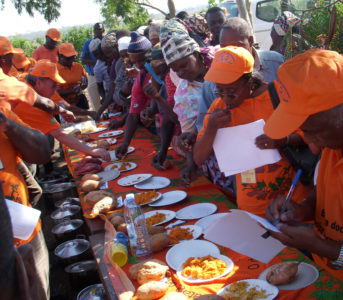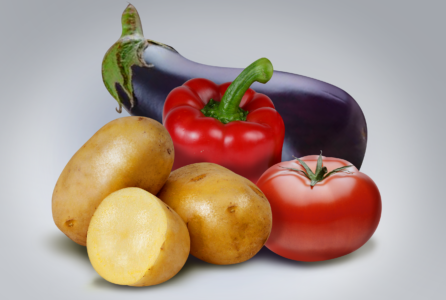
Tigray is one of the regions in Ethiopia with the highest levels of maternal and child malnutrition and food insecurity. Grain-led approaches have failed to address these issues, with vitamin A deficiency rates remaining high. This intervention aims to tackle the problem by promoting greater dissemination of biofortified orange-fleshed sweetpotato.
Background
Efforts to address the problem of food and nutrition insecurity through a grain-led approach alone (cereals are the predominant staples throughout Ethiopia) have failed to keep up with population increase, climate change and socio-economic transformation. Vitamin A deficiency rates remain high in Tigray. Potato and sweetpotato are particularly appropriate crops for smallholders because they can produce more nutritious food for each unit of area and time. The intervention to increase the introduction and widen the dissemination of biofortified orange-fleshed sweetpotato will result in a significant improvement in overall vitamin A intake and nutritional status.
Orange-fleshed sweetpotato is an ideal food and nutritionsecurity crop: it is highly productive within 3–4-month growing periods, is highly nutritious and produces more edible protein per hectare a day than rice or wheat. It has high levels of beta-carotene, a precursor to vitamin A, and carbohydrates, providing a relatively cheap source of vitamin A and the energy needed for normal child health. It is also an excellent source of fiber and other essential vitamins and minerals, including vitamins B, C and E as well as minerals such as iron and zinc. Promoting increased production and consumption of orange-fleshed sweetpotato in Tigray is both feasible and sustainable in the long term. Compared with other crops, the cultivation of sweetpotato is less labor and capital intensive, making it a suitable option for resource-constrained rural farmers, including women.
Objectives
- Help improve nutrition and food security in vulnerable households with young children (under two years) and women of reproductive age in the target districts of the Tigray region
- Scale up the production and consumption of vitamin A-rich orange-fleshed sweetpotato as part of a more diversified diet among at least 16,000 vulnerable households by increasing production and demand for the crop and strengthening institutional and policy support for nutrition-sensitive agriculture.
Approach
Many farmers in the project intervention zone find it difficult to sustain sweetpotato production due to shortages of planting material. The International Potato Center (CIP) developed a technique to preserve selected roots in sand and enable early sprouting at the onset of new rains, known as Triple-S—storage in sand and sprouting.
Working closely with the Tigray Agricultural Research Institute (TARI), Tigray Bureau of Agriculture and Rural Development (BoARD) and Bureau of Health (BoH), and local NGOs, CIP builds the capacities of targeted sweetpotato seed suppliers and vine multipliers, ensuring access to quality, disease-free planting material. It also builds capacities of those involved in farmer training centers with small-scale irrigation and other facilities for vine multiplication and demonstrations.
Increasing market demand is an important driver for sustained adoption of sweetpotato by smallholder farmers, so the intervention includes a focus on increasing awareness among rural and urban populations. This work, through schools, mass media and communitybased champions, will, in turn, increase consumption of sweetpotato and create market demand. Finally, the project will strengthen the capacity of existing platformsfor advocacy to raise the priority accorded by government to sweetpotato, particularly the orange-fleshed varieties.
Expected outcomes
The main expected outcome is that, by 2020, quality vine cuttings will be distributed to at least 16,000 smallholder households with children under two years. At least 12 district agricultural experts and 48 development agents will be trained in basic sweetpotato agronomy, including planting techniques, virus and pest management, good harvesting techniques, and marketing. In collaboration with BoARD, at least 42 farmers from the target kebeles (or wards), of whom at least half will be women, will in turn receive training from trained trainers. At least one farmer field day per year will demonstrate and share experiences in sweetpotato production, and on-farm conservation of vines using Triple-S.
TARI will produce at least 400,000 disease-free orangefleshed sweetpotato vine cuttings a year. In collaboration with BoARD, through a participatory approach with farmers, the best varieties for wide-scale multiplication will be selected.
To decentralize vine multiplication and establish links with foundation seed sources, at least two farmers with access to land and a water source for irrigation will be identified and trained in each intervention kebele. Demonstration and multiplication sites will be established at five farmer training centers in the five intervention woredas (or districts).
To increase demand for the crop, orange-fleshed sweetpotato will be promoted as a nutritious food in at least five schools through school gardens, promotion activities, and agricultural and science clubs with at least 300 members. At least 40 district-level BoARD and BoH officers (secondary facilitators) will be trained on general nutrition, sweetpotato nutrition and storage, and provided with the skills for effective behavioral change communication techniques and knowledge transfer. At least 126 community-level nutrition champions will also support this activity.
In the media, at least 12 weeks of radio broadcasts will promote the key nutrition messages of orange-fleshed sweetpotato, and at least 8,000 promotional flyers will be distributed. In each project district, there will be at least one annual urban promotion at local festivals and fairs, generating interest in buying sweetpotato roots.
Key outcomes
| Target | |
| Vine cuttings distributed to households with children under two, for vitamin A-rich sweetpotato as part of diversified diet | 16,000 households |
| Disease-free sweetpotato vine cuttings produced | 400,000 a year |
| Orange-fleshed sweetpotato demonstration and multiplication | 2 farmers per district 5 farmer training centers |
| Agricultural and science clubs | 300 members |
| Community-level nutrition champions | 126 |
| Sweetpotato media promotion | 12 weeks of radio broadcasts 8,000 promotional flyers |
Contact
Haile Tesfaye
CIP, Ethiopia
h.tesfaye@cgiar.org
Thanks to our donors



